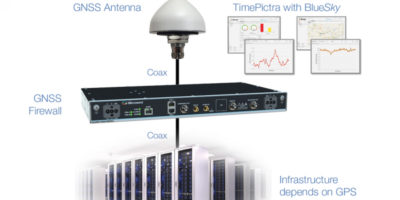At this week’s ION GNSS+ (Miami, Florida, USA, 24 to 28 September) Microsemi will exhibit the BlueSky GNSS firewall. It enables critical infrastructure providers to harden the security of their operations from GPS threats and deliver a more reliable and secure service, says the Microchip subsidiary.
Signals from global positioning systems (GPS) and other global navigation satellite system (GNSS) constellations can, if disrupted, harm infrastructure such as telecommunications, energy, transportation, emergency services and data centres, explains Microsemi.
The new BlueSky GNSS firewall is a security-hardened system which provides protection against GPS threats such as jamming, spoofing and complete outage. It also supports a range of precision timing technologies, including atomic clocks, to enable continuous operation when GPS may be completely denied for extended periods.
Microsemi has added a BlueSky option to its TimePictra software management suite, for centralised control and visibility of GPS reception across regional, national and global geographic areas.
This second-generation BlueSky GNSS firewall has expanded monitoring and reporting capabilities, and atomic clock technology to provide security-hardened resiliency, including the ability to operate in a GNSS-denied environment for more than 30 days, says Microsemi.
Using the same principles as a firewall used for network security, the BlueSky GNSS firewall, analyses the incoming GPS signal in real time to detect a range of threats before they are able to affect connected GPS receivers and related systems.
The BlueSky GNSS firewall incorporates an optional internal rubidium miniature atomic clock (MAC) enabling continuous output of the GPS signal to the downstream GPS receiver in case of complete loss of live sky GPS reception. Alternatively, Microsemi’s cesium clocks, such as the 5071A or TimeCesium 4400/4500, can be connected to the device, enabling UTC traceable time for more than 30 days.
To ensure the BlueSky GNSS Firewall is equipped to defend against an ever-evolving threat, Microsemi updates and continuously tracks GPS signal manipulation, spoofing threats, jamming attacks, multi-path signal interference, atmospheric activity and many other issues which can create GPS signal anomalies, disruptions and outages. Updates are available through a BlueSky subscription service.
Microsemi’s BlueSky GNSS firewall is available for orders now with delivery beginning in November 2018.
Visit Microsecmi at ION GNSS+, booth 612





